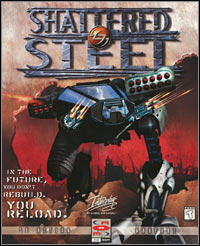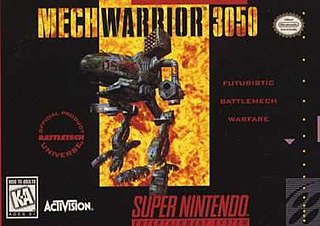BattleTech is a wargaming and military science fiction franchise launched by FASA Corporation in 1984, acquired by WizKids in 2001, which was in turn acquired by Topps in 2003; and published since 2007 by Catalyst Game Labs. The trademark is currently owned by Topps and, for videogames, Microsoft's Xbox Game Studios; Catalyst Game Studios licenses the franchise from Topps.

MechCommander is a real-time tactics video game based on FASA's BattleTech/MechWarrior franchise, developed by FASA Interactive and distributed by MicroProse in 1998. An expansion pack, Desperate Measures, was released in 1999.
MechWarrior: Dark Age was a tabletop wargame by WizKids set in the BattleTech universe that uses the Clix system. The game's miniatures are pre-painted models of infantry squads, vehicles, and giant walking war machines known as BattleMechs or more simply "'mechs".

Shattered Steel is a mech simulation game developed by BioWare and published by Interplay Productions for MS-DOS in 1996. It was later ported to Mac OS by now-defunct Logicware. It is notable for the deformable terrain effects, and for being BioWare's first developed game.

Buck Rogers: Countdown to Doomsday is a role-playing video game set in the Buck Rogers XXVC universe. It was published in 1990 by Strategic Simulations for MS-DOS, Commodore 64, and Amiga. A Sega Genesis version was released in 1991. Buck Rogers: Matrix Cubed is the 1992 sequel.

BattleTech: The Crescent Hawk's Inception is a turn-based adventure/role-playing video game released in 1988 by Westwood Associates and based on the BattleTech franchise. It was one of the first commercial ports of the licence, and featured some of the franchise's worlds, institutions, political figures, and weapons, particularly the three-story tall BattleMechs. It was followed by a sequel, BattleTech: The Crescent Hawk's Revenge, though that game featured significantly different gameplay, falling into the real-time tactics genre rather than adventure/role-playing.

MechWarrior 4: Vengeance is a vehicle simulation game, developed by FASA Interactive and published by Microsoft. It was released on November 22, 2000. It is the fourth game in MechWarrior series. It takes place in BattleTech universe where the pinnacle of all war machines are huge, heavily armed robots called BattleMechs. The player pilots one of these "'Mechs" and uses variety of available weapons to battle enemy 'Mechs, tanks and other vehicles. An expansion pack, MechWarrior 4: Black Knight, was released in 2001, and a subsequent stand-alone expansion, MechWarrior 4: Mercenaries, was released on November 7, 2002. Two smaller expansions, Inner Sphere 'Mech Pak and Clan 'Mech Pak, were also released in 2002.

MechWarrior 2: 31st Century Combat is a vehicle simulation game developed and published by Activision, released in 1995 as part of the MechWarrior series of video games in the BattleTech franchise. The game is set in 3057, and is played as a tactical simulation that incorporates aspects of real-time first-person combat and the physical simulation of the player's mech. It is a game recreation of the "Refusal War." The player can join one of the clans, Clan Jade Falcon or Clan Wolf while engaging in up to 32 missions.
Multiplayer BattleTech is a PC MMORPG BattleTech game developed by Kesmai and featured on the now defunct GEnie online gaming network.

MechWarrior 3 is a vehicle simulation game, part of the MechWarrior series. It featured a new 3D accelerated graphics engine at the time of its release. The game contains over 20 missions, with access to 18 different mechs. A novelization called Trial Under Fire was written by Loren L. Coleman.

Mechwarrior 4: Mercenaries is a vehicle simulation video game for Microsoft Windows, released in 2002. It is a standalone expansion of MechWarrior 4: Vengeance, based on the BattleTechMechWarrior game universe.

BattleTech: The Crescent Hawks' Revenge is a real-time tactics game based in the FASA BattleTech universe. It is a direct sequel to BattleTech: The Crescent Hawk's Inception, though the gameplay is considerably different from that of the first title, which was primarily an adventure/role-playing game. Developed by Westwood Associates for Mediagenic, and produced by Scott Berfield, the game serves as a prototype for what later became Dune II, the first real-time strategy title on the PC.

MechWarrior, known in Japan as BattleTech (バトルテック), is a first-person action video game for the Super NES set in the BattleTech universe. The SNES game was based upon the original PC MechWarrior, with updated graphics that utilized Mode 7 for the Battlemech mission sequences instead of the PC version's flat-shaded 3D graphics.

MechWarrior 3050, also known as BattleTech in its original Sega Genesis release and in Japan as BattleTech 3050 (バトルテック3050), is a 1994 mech-based video game developed by Malibu. The first BattleTech based game to be released for the Sega Genesis, it was later ported to the Super Nintendo by Activision as MechWarrior 3050. The Super Nintendo game was localized and published in Japan by Ask Group.

MechWarrior 2: Mercenaries is a video game released in September 1996 as a stand-alone expansion to MechWarrior 2: 31st Century Combat and the last BattleTech game made by Activision. In this game, the player takes control of an Inner Sphere mercenary squad, with control over finances and free choice of missions.

Mechwarrior: Living Legends is a free, fan-created multiplayer-only game based in the BattleTech universe - originally a total-conversion mod for Crysis, it's since become stand-alone - running on Crysis Wars, and using CryEngine 2 as its engine. It's one of the few mods based on the BattleTech universe to have been sanctioned by Microsoft—who currently owns the rights to the Mechwarrior video-game franchise—and additionally received pre-SDK support and sanctioning directly from Crytek, producers of the games' engine. On December 26, 2009, an open beta was released via BitTorrent and other distribution methods. Because the project changes the play-style and feel of the game it is originally based on so completely as to be unrecognizable in comparison, it is billed as a "full-conversion" mod, since little to no trace of the original game's art or play-style exists any longer within MW:LL. It was created by American developer Wandering Samurai Studios.

MechWarrior Online is a free-to-play vehicle simulation video game, officially launched during September 2013 by Piranha Games for Microsoft Windows. The game takes place within the larger BattleTech universe.

BattleTech is a Mecha turn-based strategy video game developed by Harebrained Schemes and published by Paradox Interactive. It was released on macOS and Windows on April 24, 2018, with a Linux release on November 27, 2018. The developers set aside US$1 million to create the game, and turned to Kickstarter to secure funding for additional features, including a single player campaign, an expansion of that campaign, and a player versus player multiplayer mode.

MechWarrior: Tactical Command is a real-time strategy game based on the BattleTech universe developed for iOS. It was developed by Singaporean studio Personae Studios and released on September 27, 2013. The mobile game supports all iOS 5.0 and above devices including the iPhone, iPod Touch, and iPad.

MechWarrior 5: Mercenaries is a BattleTech mecha game developed by Piranha Games released on December 10, 2019, on Microsoft Windows. It is the first single player MechWarrior game since 2002. It was initially available as an Epic Games Store exclusive title, which, like other games with Epic Games Store exclusivity deals, was met with criticism. On May 7, 2020, it was made available through Xbox Game Pass for PC. On May 27, 2021, it was made available on additional platforms including Xbox Series X/S, Xbox One, Steam and GOG, in addition to the DLC pack Heroes of the Inner Sphere, Call to Arms, and Rise of Raselhague. It features ray tracing powered by Nvidia RTX as well as DLSS.


















